Body mass index in Saudi Arabian children and adolescents: a national reference and comparison with international standards
- PMID: 19700890
- PMCID: PMC3290051
- DOI: 10.4103/0256-4947.55162
Body mass index in Saudi Arabian children and adolescents: a national reference and comparison with international standards
Abstract
Background and objectives: Because there are no reference standards for body mass index (BMI) in Saudi children, we established BMI reference percentiles for normal Saudi Arabian children and adolescents and compared them with international standards.
Subjects and methods: Data from a stratified multistage probability sample were collected from the 13 health regions in Saudi Arabia, as part of a nationwide health profile survey of Saudi Arabian children and adolescents conducted to establish normal physical growth references. Selected households were visited by a trained team. Weight and length/height were measured and recorded following the WHO recommended procedures using the same equipment, which were subjected to both calibration and intra/interobserver variations.
Results: Survey of 11 874 eligible households yielded 35 275 full-term and healthy children and adolescents who were subjected to anthropometric measurements. Four BMI curves were produced, from birth to 36 months and 2 to 19 years for girls and boys. The 3rd , 5 th , 10th , 25th , 50th , 75th , 85th , 90th , 95th , and 97th percentiles were produced and compared with the WHO and CDC BMI charts. In the higher percentiles, the Saudi children differed from Western counterparts, indicating that Saudi children have equal or higher BMIs.
Conclusion: The BMI curves reflect statistically representative BMI values for Saudi Arabian children and adolescents.
Figures
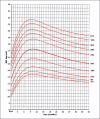
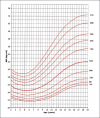
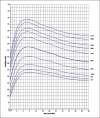
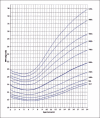
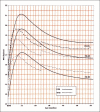


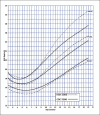
Similar articles
-
Comparison of the 2005 growth charts for Saudi children and adolescents to the 2000 CDC growth charts.Ann Saudi Med. 2008 Sep-Oct;28(5):334-40. doi: 10.5144/0256-4947.2008.334. Ann Saudi Med. 2008. PMID: 18779639 Free PMC article.
-
Growth reference for Saudi preschool children: LMS parameters and percentiles.Ann Saudi Med. 2016 Jan-Feb;36(1):2-6. doi: 10.5144/0256-4947.2016.2. Ann Saudi Med. 2016. PMID: 26922681 Free PMC article.
-
Growth reference for Saudi school-age children and adolescents: LMS parameters and percentiles.Ann Saudi Med. 2016 Jul-Aug;36(4):265-8. doi: 10.5144/0256-4947.2016.265. Ann Saudi Med. 2016. PMID: 27478912 Free PMC article.
-
[Height and weight standardized growth charts for Chinese children and adolescents aged 0 to 18 years].Zhonghua Er Ke Za Zhi. 2009 Jul;47(7):487-92. Zhonghua Er Ke Za Zhi. 2009. PMID: 19951507 Chinese.
-
[WHO growth standards for infants and young children].Arch Pediatr. 2009 Jan;16(1):47-53. doi: 10.1016/j.arcped.2008.10.010. Epub 2008 Nov 25. Arch Pediatr. 2009. PMID: 19036567 Review. French.
Cited by
-
BMI, Dental Caries, and Risk Factors among Elementary School Children: A Cross-Sectional Study.Children (Basel). 2024 Sep 21;11(9):1145. doi: 10.3390/children11091145. Children (Basel). 2024. PMID: 39334677 Free PMC article.
-
Prevalence of Obesity and Dental Caries in Kindergarten Children During the First Decade of Saudi Vision 2030: A Cross-Sectional Study.Children (Basel). 2024 Dec 18;11(12):1531. doi: 10.3390/children11121531. Children (Basel). 2024. PMID: 39767960 Free PMC article.
-
Secondary School Male Students Perception Towards Their Weight, Almethnab Town, Qassim, Saudi Arabia.Cureus. 2021 Dec 12;13(12):e20370. doi: 10.7759/cureus.20370. eCollection 2021 Dec. Cureus. 2021. PMID: 35036204 Free PMC article.
-
The prevalence of overweight/obesity in high school adolescents in Jeddah and the association of obesity association with dental caries.Ann Saudi Med. 2017 Mar-Apr;37(2):114-121. doi: 10.5144/0256-4947.2017.114. Ann Saudi Med. 2017. PMID: 28377540 Free PMC article.
-
Metabolic Syndrome: Prevalence and Risk Factors among Adolescent Female Intermediate and Secondary Students in Saudi Arabia.Int J Environ Res Public Health. 2021 Feb 22;18(4):2142. doi: 10.3390/ijerph18042142. Int J Environ Res Public Health. 2021. PMID: 33671739 Free PMC article.
References
-
- Quetelet LAJ. Physique Socialle. Vol 2. Brussels: C Muquardt; 1869.
-
- Kamp J. Ein Korperproperti Onsegesetzy zur beurteilung der langegewitchstund – abweicher populations – altergruppe. Munchener Medizinische Wochenschrift. 1921;68:976–8.
-
- WHO multicenter growth reference group. Assessment of differences in linear growth among population in the WHO multicenter growth references study. Acta Paediatr. 2006;450:56–65. - PubMed
-
- Kuczmarski RJ, Ogden CL, Guo SS, Grummer-Strawn LM, Flegal KM, Mei Z, et al. The 2000 CDC growth charts for the United States: methods and development. Vital Health Stat 11. 2004;246:1–190. - PubMed
-
- Lynch J, Wang XL, Wilcken DE. Body mass index in Australian children: recent changes and relevance of ethnicity. Arch Dis Child. 2000;82:16–20. - PubMed
MeSH terms
LinkOut - more resources
Full Text Sources
Medical

